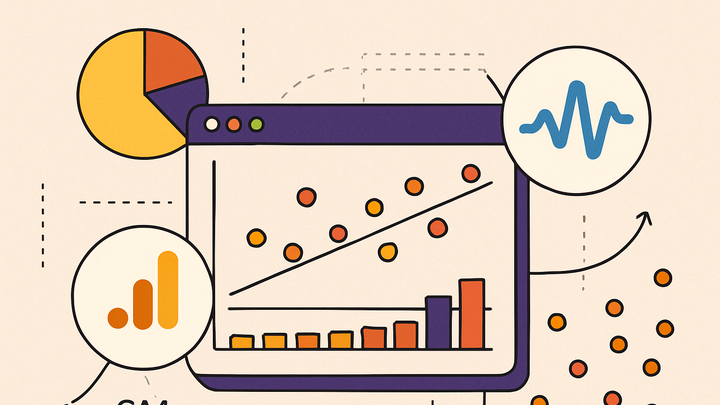Published on 2025-06-26T04:47:21Z
What is Statistical Modeling? Examples in Analytics
Statistical modeling is the process of applying mathematical frameworks to interpret, summarize, and predict outcomes from data. In the analytics industry, it allows teams to move beyond basic metrics—such as pageviews and sessions—to uncover relationships between variables (e.g., session duration vs. conversion rate) and forecast future trends.
Common methods include regression analysis, time series modeling, and clustering, each suited to specific data structures and business questions. Tools like PlainSignal (a cookie-free analytics platform) and Google Analytics 4 (GA4) provide the raw event data necessary to train and validate statistical models. By exporting data from these platforms into statistical software (e.g., R or Python) or leveraging built-in predictive features in GA4, analysts can derive actionable insights that guide product decisions, marketing strategies, and user experience improvements.
Statistical modeling
Applies mathematical techniques to analytics data to uncover patterns, forecast trends, and drive data-driven decisions.
Why Statistical Modeling Matters
Statistical modeling transforms raw analytics data into meaningful insights by capturing relationships and predicting future outcomes. It helps teams move beyond surface metrics to understand the underlying drivers of user behavior. By applying statistical models, analysts can optimize experiences, forecast traffic, and quantify uncertainty in decision-making.
-
Informed decision-making
Models quantify relationships between variables, enabling data-driven strategies such as optimizing conversion funnels based on key predictors.
-
Forecasting and trend analysis
By fitting time series models, analysts can project future user engagement, revenue, or resource needs with confidence intervals.
-
Hypothesis testing
Statistical frameworks allow testing marketing or product hypotheses to validate which changes lead to significant improvements.
Common Statistical Modeling Techniques
Analysts choose among multiple modeling methods based on data structure and business goals. Below are core techniques often used in web analytics.
-
Regression analysis
Estimates relationships between variables to understand influence and make predictions.
-
Linear regression
Models numeric outcomes by fitting a line that minimizes squared error between observed and predicted values.
-
Logistic regression
Predicts binary outcomes (e.g., conversion vs. no conversion) by modeling the log-odds as a linear function.
-
-
Time series analysis
Accounts for temporal dependencies to model trends, seasonality, and irregular components in sequential data.
-
Arima models
Combines autoregression and moving average to capture complex temporal patterns.
-
Exponential smoothing
Applies weighted averages with decreasing weights for older observations, useful for simple forecasting.
-
-
Clustering and segmentation
Groups users or sessions into homogenous segments based on behavior or attributes.
-
K-means clustering
Partitions observations into k clusters by minimizing within-cluster variance.
-
Hierarchical clustering
Creates a tree of clusters through iterative merging or splitting, allowing for nested segmentation.
-
Implementing Statistical Modeling with PlainSignal and GA4
Statistical modeling depends on reliable data from analytics tools. PlainSignal and GA4 both enable flexible data collection and analysis pipelines for model development and interpretation.
-
Data collection with PlainSignal
Embed PlainSignal’s lightweight, cookie-free tracking snippet into your pages:
<link rel="preconnect" href="//eu.plainsignal.com/" crossorigin /> <script defer data-do="yourwebsitedomain.com" data-id="0GQV1xmtzQQ" data-api="//eu.plainsignal.com" src="//cdn.plainsignal.com/plainsignal-min.js"></script> -
Data collection with GA4
Use Google’s gtag.js to gather detailed event data and user properties:
<script async src="https://www.googletagmanager.com/gtag/js?id=G-XXXXXXX"></script> <script> window.dataLayer = window.dataLayer || []; function gtag(){dataLayer.push(arguments);} gtag('js', new Date()); gtag('config', 'G-XXXXXXX'); </script> -
Building statistical models
Export raw event data via PlainSignal’s API or GA4 BigQuery integration and leverage Python/R libraries (e.g., scikit-learn, statsmodels) to train and validate models.
-
Visualizing and interpreting results
Use GA4 Explorations, PlainSignal dashboards, or BI tools like Looker Studio to plot predictions, residuals, and confidence intervals for stakeholder communication.
Best Practices and Common Pitfalls
Robust statistical modeling involves disciplined data handling, validation, and iterative improvement to avoid misleading outcomes.
-
Ensure data quality
Clean and preprocess data: remove duplicates, handle missing values, and verify event schema consistency.
-
Avoid overfitting
Apply cross-validation, holdout sets, and regularization techniques to ensure models generalize to new data.
-
Regular validation and monitoring
Continuously track model accuracy, retrain with fresh data, and monitor for data drift or changes in user behavior.
